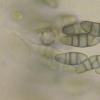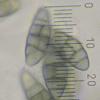
12-12-2025 18:39
Mirek GrycHello everyone.Macrofeatures similar to Mollisia b

09-12-2025 12:06
 Andgelo Mombert
Andgelo Mombert
Bonjour,Je recherche l'article concernant Hypobryo

07-12-2025 16:07
Arnold BüschlenHallo, ich habe in einer Moos-Aufsammlung (epiphy

08-12-2025 21:04
Mark Stevens"Hello everyone,I'm relatively new to microscopy (

08-12-2025 18:59
 Lothar Krieglsteiner
Lothar Krieglsteiner
.. found by a seminar-participant, I do not know t

08-12-2025 17:37
 Lothar Krieglsteiner
Lothar Krieglsteiner
20.6.25, on branch of Abies infected and thickened

16-03-2014 22:00
Hello,I found this species a few months ago but ha

08-12-2025 13:39
Thomas Læssøehttps://svampe.databasen.org/observations/10572899
Capronia
Alain GARDIENNET,
22-12-2011 09:43
Comment s'appelle ce petit Capronia poilu, à poils courts, très fréquent sur vieux bois décortiqués, possédant des spores gris-bleu de 15-17 x 5,5-6,5 µm avec 1-2 (3) cloisons longitudinales et 3-4-5 cloisons transversales ?
J'ai un trou de mémoire.
Merci d'avance,
Alain
Hans-Otto Baral,
22-12-2011 09:44

Re : Capronia
quelques images?
Christian Lechat,
22-12-2011 12:07

Re : Capronia
selon l'image N°7, ça ne ressemble pas à un Capronia,
Christian
Christian
Alain GARDIENNET,
22-12-2011 12:14
Hans-Otto Baral,
22-12-2011 12:31

Re : Capronia
Among the images I have in my files C. pulcherrima seems to fit.
Could you please check IKI, if it stains the asci or the hymenial gel in reddish? If not sure, a clearer result can be obtained when KOH-pretrated (then hymenium turns pale blue). Probably not all Capronias have that hemiamyloid reaction, but many.
I saw only the two spore photos, not the 7 photos which Christian mentioned.
Schmid-ascomyceten im Bild 1&2_Page_214.jpg?
Zotto
Could you please check IKI, if it stains the asci or the hymenial gel in reddish? If not sure, a clearer result can be obtained when KOH-pretrated (then hymenium turns pale blue). Probably not all Capronias have that hemiamyloid reaction, but many.
I saw only the two spore photos, not the 7 photos which Christian mentioned.
Schmid-ascomyceten im Bild 1&2_Page_214.jpg?
Zotto
Gernot Friebes,
22-12-2011 14:33
Re : Capronia
Hi Alain,
I agree with Zotto that this species resembles to C. pulcherrima due to ascospore morphology but in this species the ascospores rarely exceed 15 µm in length and mostly are less than 5 µm wide. The size of your ascospores fits better for C. semi-immersa (=C. svrcekiana according to Untereiner et al. 2008 in Botany, 86(7): 742-750) which is known from wood and old polypores. You find illustrations and descriptions of this species in:
Candoussau, F. & Sulmont, P. 1972 [1971]. - Dictyotrichiella semiimmersa nov. sp. Rev. Mycol. 36(3-4): 238-242.
Janex-Favre, M.C. 1988. - Étude ontogénique et structurale des périthèces du Dictyotrichiella semiimmersa Candoussau et Sulmont (Pyrénomyctètes, Herpotrichiellaceae). Cryptogamie, Mycol. 9(2): 133-151.
Réblová, M. 1996. - Two new Capronia species from the Czech Republic. Czech Mycol. 49(2): 77-83 (as C. svrcekiana).
Capronia species with submuriform ascospores are a difficult group though and it would be necessary to take cultures of many collections to find out more about the delimination of the species.
Best wishes,
Gernot
I agree with Zotto that this species resembles to C. pulcherrima due to ascospore morphology but in this species the ascospores rarely exceed 15 µm in length and mostly are less than 5 µm wide. The size of your ascospores fits better for C. semi-immersa (=C. svrcekiana according to Untereiner et al. 2008 in Botany, 86(7): 742-750) which is known from wood and old polypores. You find illustrations and descriptions of this species in:
Candoussau, F. & Sulmont, P. 1972 [1971]. - Dictyotrichiella semiimmersa nov. sp. Rev. Mycol. 36(3-4): 238-242.
Janex-Favre, M.C. 1988. - Étude ontogénique et structurale des périthèces du Dictyotrichiella semiimmersa Candoussau et Sulmont (Pyrénomyctètes, Herpotrichiellaceae). Cryptogamie, Mycol. 9(2): 133-151.
Réblová, M. 1996. - Two new Capronia species from the Czech Republic. Czech Mycol. 49(2): 77-83 (as C. svrcekiana).
Capronia species with submuriform ascospores are a difficult group though and it would be necessary to take cultures of many collections to find out more about the delimination of the species.
Best wishes,
Gernot
Hans-Otto Baral,
22-12-2011 14:59

Re : Capronia
Thanks, Gernot, that helps a lot!! Anyhow I would be happy to know the iodine reaction which is currently neglected in the literature.
Zotto
Zotto
Alain GARDIENNET,
22-12-2011 20:30
Re : Capronia
Hi friends,
I'm reading the discussion.
I'm agree with you, it can't be C. pulcherrima, because of ascospores'size. Ascospores look like nigerrima's ones. But it isn't this fungicolus species. So I will look at semi-immers and I'm about to test KOH+ iode reaction at once.
I talk you soon,
alain
I'm reading the discussion.
I'm agree with you, it can't be C. pulcherrima, because of ascospores'size. Ascospores look like nigerrima's ones. But it isn't this fungicolus species. So I will look at semi-immers and I'm about to test KOH+ iode reaction at once.
I talk you soon,
alain
Alain GARDIENNET,
22-12-2011 21:14
Re : Capronia
No iodine reaction with or not with KOH.
Gernot, I haven't found one of the descriptions. Untereiner only is on line and it doesn't give the description of the teleomorph.
I add : setae up to 30 µm long and ascomatal wall is 10-15 µm wide.
Thanks to all of you,
Alain
Gernot, I haven't found one of the descriptions. Untereiner only is on line and it doesn't give the description of the teleomorph.
I add : setae up to 30 µm long and ascomatal wall is 10-15 µm wide.
Thanks to all of you,
Alain
Alain GARDIENNET,
23-12-2011 21:19
Re : Capronia
Very probably C. semi-immersa, as you said Gernot. You're a boss with Capronia !
Thank you,
Alain
PS : an important number of ascomatas were actually semi-immersed and host is Populus.
Thank you,
Alain
PS : an important number of ascomatas were actually semi-immersed and host is Populus.
francoise candoussau,
25-12-2011 17:24
Re : Capronia F.Candoussau 25.12.11
Avec les correspondances que j'ai eues avec Martina Reblova (1998)et Wendy Untereiner des cultures étaient nécéssaires pour établir la synonymie avec C.svrcekiana et placer D .semi im vimersa dans les Capronia mon matériel était trop vieux..Ou en de me le dire est-on ,??Merci de me le dire!

